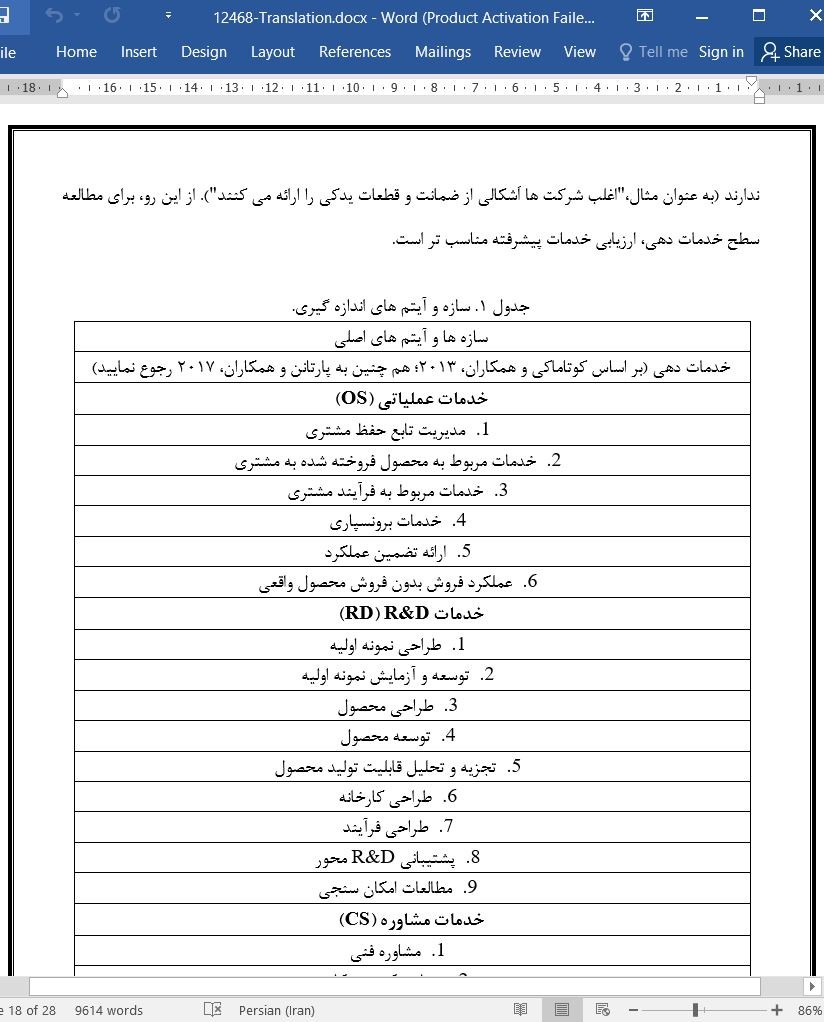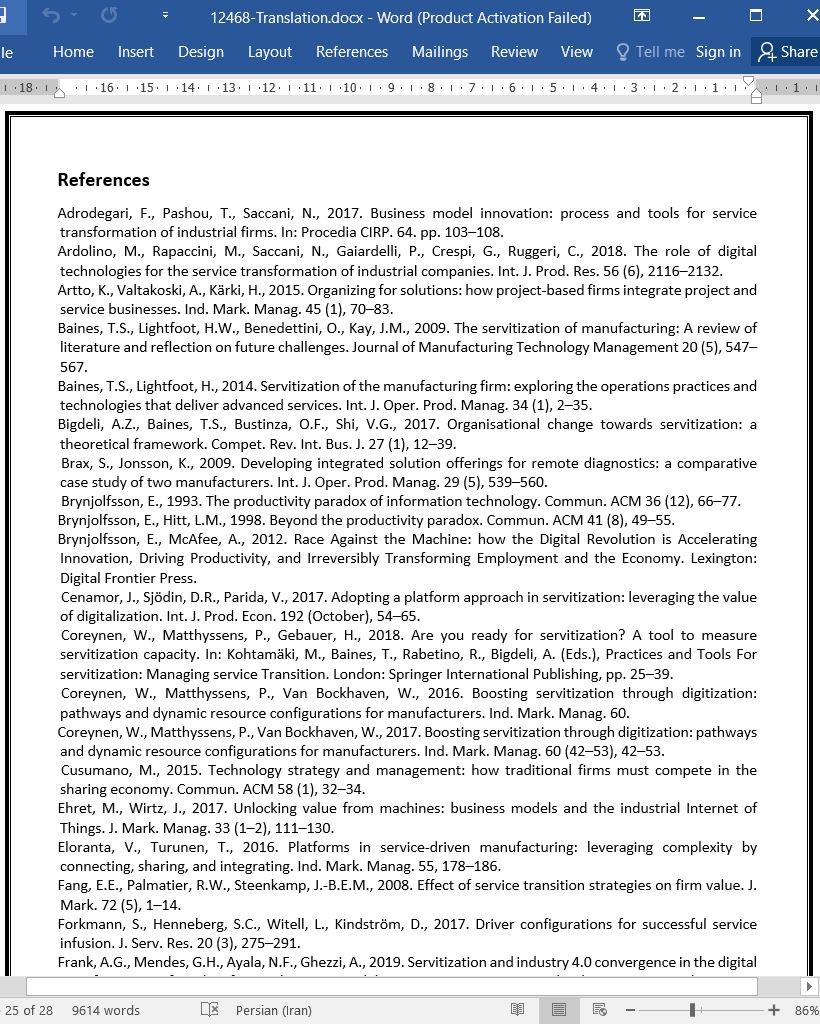
دانلود مقاله رابطه بین دیجیتال سازی و خدمات دهی
چکیده
پژوهش حاضر به بررسی اثر برهمکنش بین دیجیتال سازی و خدمات دهی بر عملکرد مالی شرکت های تولیدی می پردازد. ما فرض ساده خطی بین دیجیتال سازی و عملکرد مالی را با نمونه ای از 131 شرکت تولیدی به چالش کشیده و اثر برهمکنش غیرخطی بین دیجیتال سازی و خدمات دهی را بر عملکرد مالی فرض نمودیم. از سطح پایین تا متوسط دیجیتال سازی، اثر برهمکنش بین دیجیتال سازی و خدمات دهی بالا بر عملکرد مالی شرکت منفی و معنی دار است. از سطح متوسط تا بالای دیجیتال سازی، تعامل بین دیجیتال سازی و خدمات دهی بالا مثبت و معنی دار شده و عملکرد مالی شرکت ها را بهبود می بخشد. نتایج بیانگر ضرورت تعامل موثر بین دیجیتال سازی و خدمات دهی یعنی خدمات دهی دیجیتالی می باشد. بدون این تعامل، یک شرکت تولیدی با تناقض در دیجیتال سازی مواجه می شود. مطالعه حاضر ضمن ارائه نکاتی درباره رابطه پیچیده بین دیجیتال سازی و عملکرد مالی به مدیران شرکت های تولیدی، بر ارزش خدمات دهی در هدایت عملکرد مالی از طریق دیجیتال سازی تاکید می نماید. بنابراین، مطالعه حاضر به تبیین نحوه تبدیل شرکت های تولیدی به شرکت های داده محور با پیشرفت خدمات دهی می پردازد.
1. مقدمه
خدمات دهی دیجیتالی، مفهوم نوظهوری است که بر تعامل بین دو سازه مرکزی در شرکت های تولیدی و فناوری یعنی: دیجیتال سازی و خدمات دهی تاکید دارد (کورینن و همکاران، 2016؛ کوتاماکی و همکاران، 2019؛ اوپرسنیک و تایش، 2015؛ پاشو و همکاران، 2017). دیجیتال سازی تاثیر چشمگیری بر شرکت ها، عملیات بالا دستی و پایین دستی، شبکه ها و اکوسیستم ها دارد (یانسیتی و لاخانی، 2014؛ جاکوبیدز و همکاران، 2018؛ پورتر و هپلمان، 2014). شرکت هایی مانند رولز - رویس، کن، کاترپیلار و هیلتی به سمت مدل های کسب و کار دیجیتالی، زنجیره های ارزش مبتنی بر داده و اَشکال سازمانی انعطاف پذیرتر و حتی عملیات چابک تر حرکت کرده اند. این گذار به سوی دیجیتال سازی، محصولات هوشمند، اینترنت اشیاء (IoT) و اینترنت صنعتی، قابلیت های لازم برای شرکت های تولیدی را که بنا بر گزارشات درگیر این گذار هستند تغییر داده است (یانسیتی و لاخانی، 2014؛ پورتر و هپلمان، 2015). علاوه بر تغییر قابلیت های لازمه، دیجیتال سازی تغییرات شگرفی را در معاملات درون سازمانی (مانند بلاک چین) (تاپسکات و تاپسکات، 2017)، روابط قدرت بین شرکت ها (مانند شرکت های اوبر و خودروسازی) (کوسومانو، 2015) و هویت های استراتژیک (مانند شبیه شدن شرکت های تولیدی به شرکت های نرم افزاری) (لنکا و همکاران، 2018) ایجاد نموده است. با این حال، شرکت های تولیدی پیوسته در حال سرمایه گذاری بر روی تشخیص از راه دور، انبار داده ها، تجزیه و تحلیل و روش های مختلف تجسم داده ها (گروبیک، 2018؛ جانسون و همکاران، 2009؛ تیلسون و همکاران، 2010) به منظور تسهیل در ارتقاء تصمیمات، هوش کسب و کار و توسعه کسب و کار با شواهد محدودی از حصول سود واقعی هستند (تالاوی، 2018).
6.3. محدودیت ها و پیشنهاداتی برای تحقیقات بعدی
همانند هر مطالعه ای، مطالعه حاضر نیز بدون محدودیت نیست. مطالعه حاضر از نمونه نسبتاً کوچکی از شرکت های تولیدی سوئدی استفاده می کند که تعمیم پذیری را محدود می سازد. مطالعات آتی می توانند بر تعدیل کننده ها و واسطه های دیگری به منظور شناخت بیشتر روابط غیرخطی بین خدمات دهی دیجیتالی و عملکرد شرکت تمرکز نمایند. افزون بر این، از آنجایی که مطالعه حاضر به آزمایش ارتباط بین دیجیتال سازی و عملکرد مالی پرداخت، اثرات دیجیتال سازی باید برای انواع دیگری از متغیرهای نتیجه مانند رشد فروش و ارزش بازاری شرکت نیز مورد مطالعه قرار گیرد. نهایتاً، مطالعات عمیق کیفی می توانند به توسعه درک دقیق تر قابلیت ها، شیوه ها و شالوده های خرد مورد نیاز کمک نمایند.
Abstract
The present study investigates the effect of the interaction between digitalization and servitization on the financial performance of manufacturing companies. We challenge the simple linear assumption between digitalization and financial performance with a sample of 131 manufacturing firms and hypothesize a nonlinear U-shaped interaction effect between digitalization and servitization on financial performance. From low to moderate levels of digitalization, the interaction effect between digitalization and high servitization on company financial performance is negative and significant. From moderate to high levels of digitalization, the interplay between digitalization and high servitization becomes positive and significant, improving companies’ financial performance. The results demonstrate the need for an effective interplay between digitalization and servitization, the digital servitization. Without this interplay, a manufacturing company may face the paradox of digitalization. For managers of manufacturing companies, the study provides insights into the complex relationship between digitalization and financial performance, emphasizing the value of servitization in driving financial performance from digitalization. Thus, the study demonstrates how manufacturing companies can become data-driven by advancing servitization.
1. Introduction
Digital servitization is an emerging concept that highlights the interplay between two central constructs in manufacturing and technology companies: digitalization and servitization (Coreynen et al., 2016; Kohtamäki et al., 2019; Opresnik and Taisch, 2015; Paschou et al., 2017). Digitalization is considered to have a profound effect on companies, up and downstream operations, networks and ecosystems (Iansiti and Lakhani, 2014; Jacobides et al., 2018; Porter and Heppelmann, 2014). Companies such as Rolls-Royce, Kone, Caterpillar and Hilti have been moving towards digital business models, data-based value chains, and more flexible organizational forms – even towards more agile operations. This transition towards digitalization, smart products, the Internet of Things (IoT), and the industrial internet has been shifting the capability requirements for manufacturing companies that reportedly struggle in this transition (Iansiti and Lakhani, 2014; Porter and Heppelmann, 2015). In addition to shifting the capability requirements, digitalization may also generate profound changes in interfirm transactions (e.g., blockchain) (Tapscott and Tapscott, 2017), power relationships between companies (e.g., Über and car companies) (Cusumano, 2015), and strategic identities (e.g., manufacturing firms becoming more like software companies) (Lenka et al., 2018). However, manufacturing firms are continuously investing in remote diagnostics, data warehouses, analytics and various methods of data visualization (Grubic, 2018; Jonsson et al., 2009; Tilson et al., 2010) to facilitate improved decision making, business intelligence and business development with limited evidence of real profit gains (Talaoui, 2018).
6.3. Limitations and suggestions for further research
As with every study, the current study is not without limitations. The present study uses a relatively small sample of Swedish manufacturing companies, which may limit generalizability. Future studies can focus on additional moderators and mediators to further unpack the nonlinear relationship between digital servitization and company performance. Furthermore, as the present study tested the link between digitalization and financial performance, the effects of digitalization should be further studied to a variety of additional outcome variables, such as sales growth and company market value. Finally, in-depth qualitative studies could help develop a more detailed understanding of the needed capabilities, practices and microfoundations.
H1: Servitization mitigates the inverted U-shaped relationship between digitalization and company financial performance. Moderate to high levels of digitalization combined with high levels of servitization lead to increased financial performance in manufacturing companies.
H1: خدمات دهی رابطه U شکل معکوس بین دیجیتال سازی و عملکرد مالی شرکت را کاهش می دهد. سطوح متوسط تا بالای دیجیتال سازی همراه با سطوح بالای خدمات دهی منجر به افزایش عملکرد مالی در شرکت های تولیدی می شوند.
چکیده
1. مقدمه
2. نظریه و فرضیات
2.1. دیجیتال سازی و عملکرد
2.2. خدمات دهی دیجیتالی
2.3. مدل تحقیق و فرضیه ها
2.3.1. برهمکنش بین دیجیتال سازی و خدمات دهی
3. روش ها
3.1. نمونه و گردآوری داده ها
4. متغیرها
4.1. متغیرهای وابسته
4.2. متغیر مستقل
4.3. متغیر تعدیل کننده
4.4. متغیرهای شاهد
5. نتایج
6. بحث
6.1. نقشآفرینی نظری
6.2. پیامدهای مدیریتی
6.3. محدودیت ها و پیشنهاداتی برای تحقیقات بعدی
منابع
ABSTRACT
1. Introduction
2. Theory and hypotheses
2.1. Digitalization and performance
2.2. Digital servitization
2.3. Research model and hypotheses
2.3.1. The interaction between digitalization and servitization
3. Methods
3.1. Sample and data collection
4. Variables
4.1. Dependent variable
4.2. Independent variable
4.3. Moderating variable
4.4. Control variables
5. Results
6. Discussion
6.1. Theoretical contribution
6.2. Managerial implications
6.3. Limitations and suggestions for further research
References
- ترجمه فارسی مقاله با فرمت ورد (word) با قابلیت ویرایش و pdf بدون آرم سایت ای ترجمه
- پاورپوینت فارسی با فرمت pptx
- خلاصه فارسی با فرمت ورد (word)
- متن پاراگراف به پاراگراف انگلیسی و فارسی با فرمت ورد (word)
- اصطلاحات تخصصی با فرمت اکسل



